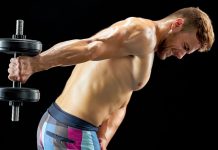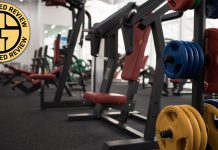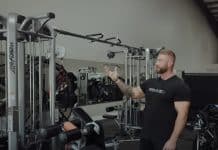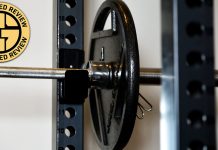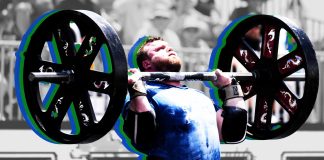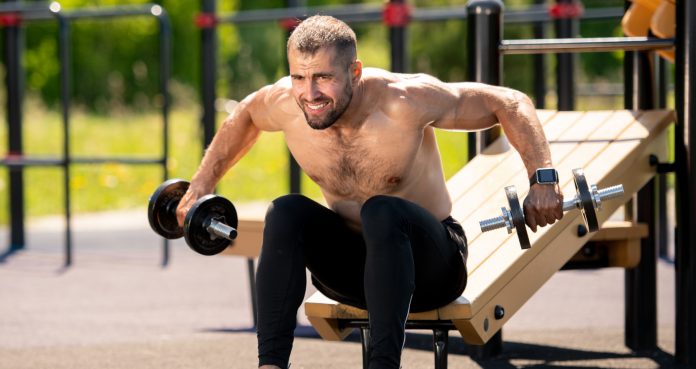
Bent over flies help round out the shoulders by engaging the posterior delts.
The rear delts, a supporting player in numerous lift and pull exercises, are crucial for achieving sculpted, 3D shoulders. Training them, however, can be slightly complex. Exercises like bent over flies effectively isolate and target your rear delts, engaging other back muscles.
Bent over flies are an excellent exercise for boosting shoulder strength and stability. All that’s needed are dumbbells, making it accessible for beginners, intermediates, and advanced athletes. Training the rear delts can be challenging, but incorporating bent over flies can significantly enhance muscle definition.
Also known as the bent over rear delt fly, reveres fly, or the bent over dumbbell fly, this exercise is a great way to build your shoulders. This guide will walk you through how to perform bent over flies and offer alternative exercises to target your rear delts. Learn the essentials and start enhancing shoulder strength today.
Techniques & Muscles Worked
Bent over flies work on your shoulders and upper back. Although it’s not completely an isolation exercise, it specifically targets your rear delts, but other upper back muscles, like the traps and rhomboids, also receive action from this exercise. This exercise requires a full range of motion to feel the correct muscles working. Here’s a step-by-step guide you can follow when doing bent over flies to get results.
- Pick up dumbbells and assume a stance with your legs slightly wider than shoulder-width distance apart.
- Engaging your core, keep your body neutral as you hinge over at your hips.
- Your arms should hang straight down in front of you. Ensure that you are holding the dumbbells with a neutral grip, as this study shows this is the best way to recruit your rear delts (1). This is your starting position.
- Taking a deep breath, pull the dumbbells up using your rear delts until your elbows and wrists get to your torso.
- Pause and slowly return the dumbbells to the starting position to complete the rep.
- Repeat for multiple reps.
Benefits
Bent over flies are a great way to build a V-taper and improve strength for other lifts. It also strengthens your shoulders, which is why it’s a part of many shoulder training routines. Below are more benefits of this exercise.
Shoulder Definition
Bent over flies effectively add size and mass to your posterior delts. When you perform them at the correct number of sets and reps, you can sculpt your shoulders and give them that 3D look, enhancing the V-taper.
Greater Upper Body Strength
Your shoulders play a crucial role in upper body strength. Packing on mass and size with bent over flies will strengthen your shoulders. This, in turn, will improve your total upper body strength.
Improved Balance & Posture
Bent over flies work on your rear delts, upper traps, and rhomboids. These muscles play a key role in balance and posture, and research shows that working on them can improve posture (2).
Reduce Injury Risk
Weak shoulders are a great injury risk as they play a role in many gym exercises. Strengthening your shoulders with bent over flies will remove that risk. It’ll also improve your exercise form, which can further prevent injuries.
Better Shoulder Mobility
When your rear delts are undeveloped, they can contribute to shoulder stiffness. Building them with bent over flies can help to improve your shoulder mobility. Bent over flies also loosen up your rotator cuffs, improving shoulder mobility.
Bent Over Flies Alternatives
Bent over flies are great for your shoulders; you should add them to your routine to round out your shoulders. However, studies show it’s essential to vary your exercises to prevent a plateau (3). Here are some great alternatives that also work on your rear delts.
Face Pull
The face pull is another great routine for your shoulders. This exercise works on your rear delts, rhomboids, and traps. Face pulls recruit your rotator cuffs, too.
Cable Rear Delt Fly
As the name shows, the cable rear delt fly also works on your rear delts. However, when hitting your back muscles, this exercise includes lats to the traps and rhomboids. Cable rear delt flyes are also great for posture and upper body strength.
Incline Bench Rear Delt Row
The incline bench rear delt row is another exercise that recruits your rear delts, rhomboids, and traps. Leg muscles like hamstrings and glutes also play a role in this exercise for stability and support.
FAQs
What muscle do bent over flys work?
Bent over flys work on your rear delts, rhomboids, and traps. This routine is excellent for increasing your shoulder strength and stability. It also helps to improve your posture.
How to do bent over flies?
To do bent over flies, you only need dumbbells and some space. This makes it ideal for those who want to train their shoulders in their home gym. For step-by-step instructions, please check the exercise guide above.
What are the benefits of the bent over fly?
The bent over fly is excellent for shoulder stability and mobility. This exercise can also help to improve muscle definition in your shoulders and sculpt your V-taper.
Follow us on Instagram, Facebook, and Twitter for more exercise guides!
References
- Schoenfeld, B., Sonmez, R. G., Kolber, M. J., Contreras, B., Harris, R., & Ozen, S. (2013). Effect of hand position on EMG activity of the posterior shoulder musculature during a horizontal abduction exercise. Journal of strength and conditioning research, 27(10), 2644–2649. https://doi.org/10.1519/JSC.0b013e318281e1e9
- Lee, D. Y., Nam, C. W., Sung, Y. B., Kim, K., & Lee, H. Y. (2017). Changes in rounded shoulder posture and forward head posture according to exercise methods. Journal of physical therapy science, 29(10), 1824–1827. https://doi.org/10.1589/jpts.29.1824
- Krzysztofik, M., Wilk, M., Wojdała, G., & Gołaś, A. (2019). Maximizing Muscle Hypertrophy: A Systematic Review of Advanced Resistance Training Techniques and Methods. International journal of environmental research and public health, 16(24), 4897. https://doi.org/10.3390/ijerph16244897



